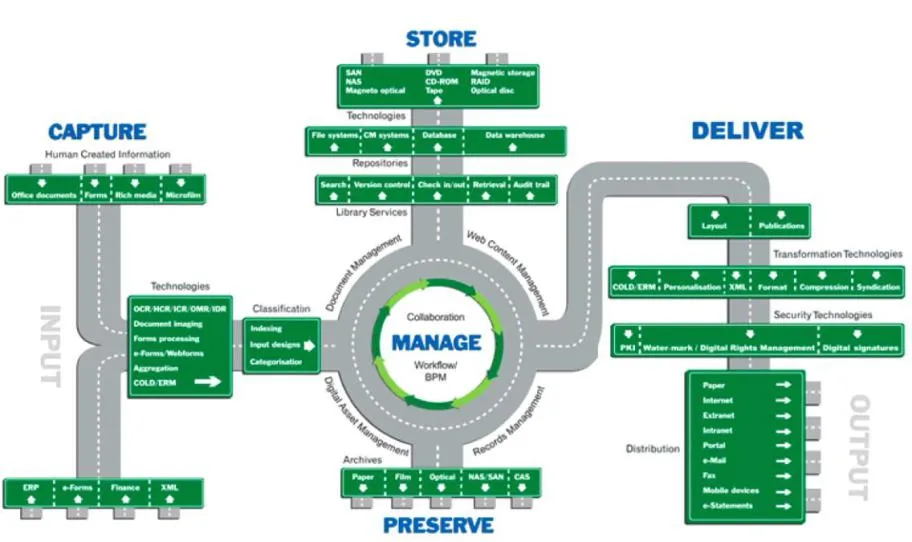AIIM Toronto seminar: @jasonbero on Microsoft’s ECM
Blog: Column 2 - Sandy Kemsley
I’ve recently rejoined AIIM — I was a member years ago when I did a lot of document capture and workflow implementation projects, but drifted away as I became more focused on process — and decided to check out this month’s breakfast seminar hosted by the AIIM Toronto chapter. Today’s presenter was Jason Bero from Microsoft Canada, who is a certified records manager and information governance specialist, talking about SharePoint and related Microsoft technologies that are used for classification, preservation, protecection and disposal of information assets.
He started out with AIIM’s view of the stages of information management (following diagram found online but almost certainly copyright AIIM) as a framework for describing where SharePoint fits in and their new functionality:

There’s a shift happening in information management, since a lot of information is now created natively in electronic form, may be generated by customers and employees using mobile apps, and even stored outside the corporate firewaall on cloud ECM platforms. This creates challenges in authentication and security, content privacy protection, automatic content classification, and content federation across platforms. Microsoft is adding data loss prevention (DLP) and records management capabilities to SharePoint to meet some of these challenges, including:
- Compliance Policy Center
- DLP policies and management
- Policy notification messages
- Document deletion policies
- Enhanced retention and disposition policies for working documents
- Document- and records-centric workflow with a web-based workflow design tool
- Advanced e-discovery for unstructured documents, including identifying relevant relationships between documents
- Advanced auditing, including SharePoint Online and OneDrive for Business as well as on-premise repositories
- Data governance: somewhat controversially (at my table of breakfast colleagues, anyway), this replaces the use of metadata fields with a new “tags” concept
- Rights management on documents that can be applied to both internal and external viewers of a document
AIIM describes an information classification and protection cycle: classification, labeling, encryption, access control, policy enforcement, document tracking, and document revocation; Bero described how SharePoint addresses these requirements, with particular attention paid to Canadian concerns for the local audience, such as encryption keys. I haven’t looked at SharePoint in quite a while (and I’m not really much of an ECM expert any more), but it looks like lots of functionality that boosts SharePoint into a more complete ECM and RM solution. This muscles in on some of the territory of their ISV partners who have provided these capabilities as SharePoint add-ons, although I imagine that a lot of Microsoft customers are lingering on ancient versions of SharePoint and will still be using those third-party add-ons for a while. In organizations that are pure Microsoft however, the ways that they can integrate their ECM/RM capabilites across all of their information creation, management and collaboration tools — from Office 365 to Skype For Business — provides a seamless environment for protecting and managing information.
He gave a live demo of some of these capabilites at work, showing how the PowerPoint presentation that he used would be automatically classified, shared, protected and managed based on its content and metadata, and the additional manual overrides that can be applied such as emailing him when an internal or external collaborator opens the document. Documents sent to external participants are accompanied by Microsoft Rights Management, providing the ability to see when and where people open the document, limiting or allowing downloads and printing, and allowing the originator to revoke access to the document. [Apparently, it’s now highly discouraged to send emails with attachments within Microsoft, which is a bit ironic considering that bloated Outlook pst files due to email attachments is the scourge of many IT departments.] Some of their rights management can be applied to non-Microsoft repositories such as Box, although this required a third-party add-on.
There was a question about synchronous collaborative editing of documents: you can now do this with shared Office documents using a combination of the desktop applications and browser apps, such that you see other people’s changes in the documents in real time while you’re editing it (like Google Docs), without requiring explicit check-out/check-in. I assume that this requires that the document is stored in a Microsoft repository, either on-premise or cloud, but that’s still an impressive upgrade.
One of the goals in this foray by Microsoft into more advanced ECM is to provide capabilites that are automated as much as possible, and generally easy-to-use for anything requiring manual input. This allows records management to happen on the fly by everyday users, rather than requiring a lot of intervention by trained records management people or complex custom workflows, and to have DLP policies applied directly within the tools that people are already using for creating, managing and sharing documents. Given the dominance of Microsoft on the desktop of today’s businesses, and the proliferation of SharePoint, a good way to improve compliance with better control over information assets.